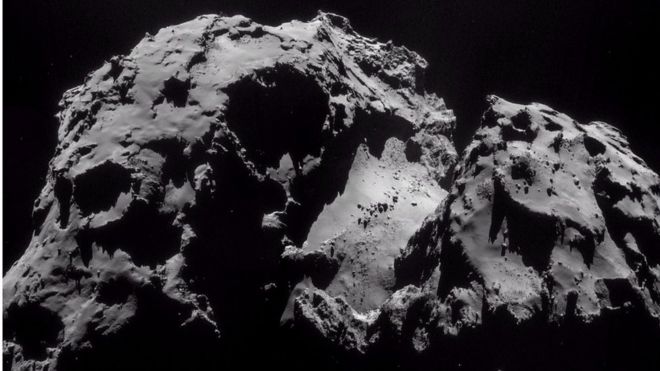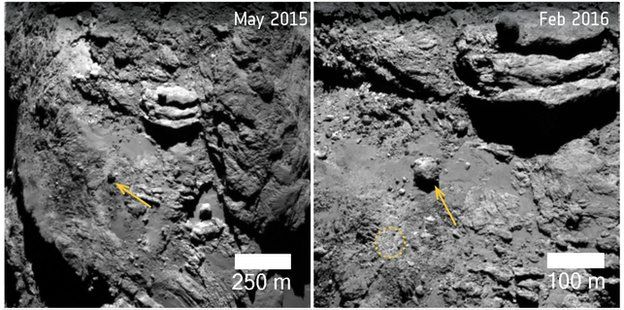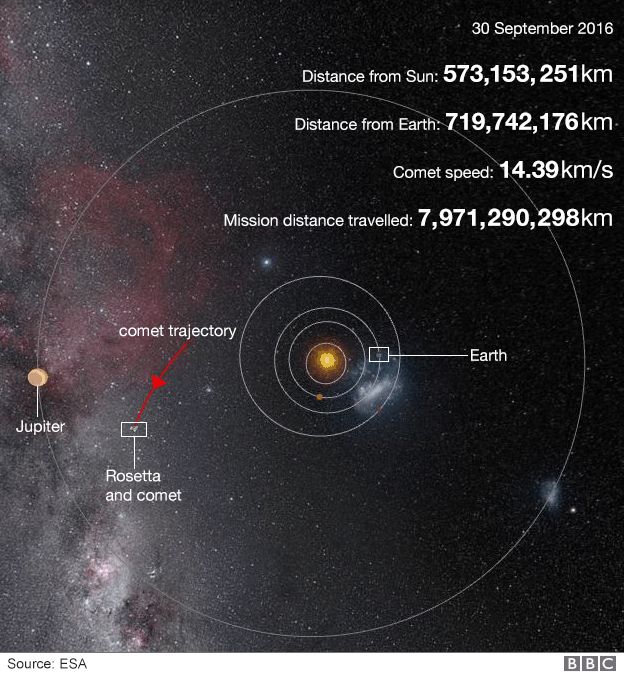22.03.2017
Rosetta saw cliffs collapse on comet
 Image copyrightESA/ROSETTA/NAVCAM
Image copyrightESA/ROSETTA/NAVCAM
The comet visited by the Rosetta spacecraft is constantly being re-shaped, sometimes in dramatic fashion.
It witnessed the collapse of entire cliffs at two locations on Comet 67P, events that were probably driven by exposure to sunlight.
The European probe documented the widespread breakdown of materials on the surface during nearly two years orbiting the 4km-wide body.
Details were presented at the Lunar and Planetary Science Conference (LPSC).
 Image copyrightESA/ROSETTA/MPS FOR OSIRIS TEAM
Image copyrightESA/ROSETTA/MPS FOR OSIRIS TEAM
Rosetta entered orbit around Comet 67P/Churyumov-Gerasimenko, to give its full name, in September 2014.
The mission enabled researchers to capture multiple images of the comet's surface features over time, to study how it changed.
"This is the first mission where we've been able to have such a huge dataset of high-resolution images, but at the same time had a long mission to a comet to study it and see how it evolves through more than two years as it journeyed through the inner Solar System," said lead author Mohamed El-Maarry, from the University of Colorado, Boulder.
Repeated heating and cooling can tease the surface materials apart, leading to erosion, say the researchers.
Dr El-Maarry and colleagues observed cliff collapses at two regions on the comet called Ash and Seth. These collapses occurred as pre-existing fractures gave way, causing sections of material tens of metres long to crumble.
In 67P's Khonsu region, a massive boulder was seen to move a distance of 140m. This could have been caused by erosion of the sloped surface the boulder was sitting on, causing it to roll. But the hefty rock could also have been moved by an outburst of dust and gas from within the comet, says the team.

At another location in the Anubis region, a steep slope retreated at a rate of 5.4m each day.
The authors note that most changes - including the erosion and the movement of boulders - occurred around perihelion, when Comet 67P was at the point in its orbital path closest to the Sun.
This suggests the events were driven by shifting patterns of exposure to sunlight.
 Image copyrightESA/ROSETTA/MPS FOR OSIRIS TEAM
Image copyrightESA/ROSETTA/MPS FOR OSIRIS TEAM
However, some of the changes were unrelated to this. In the "neck" region, which connects the two large lobes of the duck-shaped comet, a huge fracture, estimated to be more than 500m in length, extended by at least another 30m. This change is thought to be connected to an increase in the comet's spinning rate.
"We see a lot of changes, but most of those are localised," said Dr El-Maarry. "We didn't get fireworks and comets splitting and massive depressions being created. We didn't see major changes in the comet's landscape. It means we had more activity earlier in the comet's lifetime."
Comet 67P was discovered in 1969 by the Soviet astronomers Klim Churyumov and Svetlana Gerasimenko, after whom it is named.
Rosetta was dumped on the surface of the icy dirt-ball in September last year and deactivated.
The LPSC runs from 20-24 March in the Woodlands, Texas. As well as reporting the 67P observations at the meeting, Mohamed El-Marry and colleagues have written up a report for the journal Science.
A companion paper on surface changes was timed for simultaneous release in the journal Nature Astronomy. Authored by Maurizio Pajola and colleagues, this study concentrated on the circumstances surrounding the collapse of a cliff called Aswan.

Quelle: BBC
+++
COLLAPSING CLIFF REVEALS COMET’S INTERIOR
Rosetta scientists have made the first compelling link between an outburst of dust and gas and the collapse of a prominent cliff, which also exposed the pristine, icy interior of the comet.
Sudden and short-lived outbursts were observed frequently during Rosetta’s two-year mission at Comet 67P/Churyumov–Gerasimenko. Although their exact trigger has been much debated, the outbursts seem to point back to the collapse of weak, eroded surfaces, with the sudden exposure and heating of volatile material likely playing a role.
In a study published today in Nature Astronomy, scientists make the first definitive link between an outburst and a crumbling cliff face, which is helping us to understand the driving forces behind such events.
The first close images of the comet taken in September 2014 revealed a 70 m-long, 1 m-wide fracture on the prominent cliff-edge subsequently named Aswan, in the Seth region of the comet, on its large lobe.
Over the course of the following year as the comet drew ever closer to the Sun along its orbit, the rate at which its buried ices turned to vapour and dragged dust out into space increased along the way. Sporadic and brief, high-speed releases of dust and gas punctuated this background activity with outbursts.
One such outburst was captured by Rosetta’s navigation camera on 10 July 2015, which could be traced back to a portion of the comet’s surface that encompassed the Seth region.
The next time the Aswan cliff was observed, five days later, a bright and sharp edge was spotted where the previously identified fracture had been, along with many new metre-sized boulders at the foot of the 134 m-high cliff.
“The last time we saw the fracture intact was on 4 July, and in the absence of any other outburst events recorded in the following ten-day period, this is the most compelling evidence that we have that the observed outburst was directly linked to the collapse of the cliff,” says Maurizio Pajola, the study leader.
The event also provided a unique opportunity to study how the pristine water-ice otherwise buried tens of metres inside the comet evolved as the exposed material turned to vapour over the following months.
Indeed, after the event, the exposed cliff face was calculated to be at least six times brighter than the overall average surface of the comet nucleus. By 26 December 2015 the brightness had faded by half, suggesting much of the water-ice had already vapourised by that time.
And by 6 August 2016, most of the new cliff face had faded back to the average, with only one large, brighter block remaining.
Quelle: ESA




